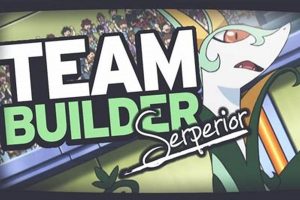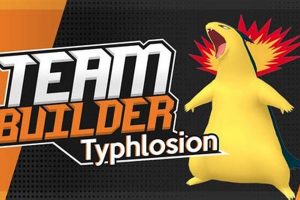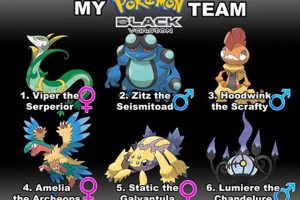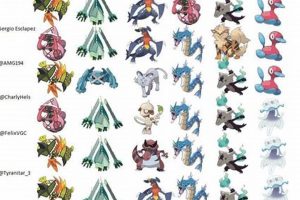This pair of titles represents an early foray into the roguelike genre within a popular media franchise. Players assume the role of a human transformed into a Pokmon, tasked with forming a team to assist other Pokmon facing natural disasters and various predicaments. Gameplay emphasizes dungeon exploration, turn-based combat, and resource management within randomly generated environments.
The release of these games marked a significant expansion of the established universe, offering a narrative that diverged from the traditional trainer-centric experience. This shift provided players with a unique perspective, fostering empathy and camaraderie amongst the diverse cast of creatures. Furthermore, the titles introduced a compelling narrative arc centered around mitigating environmental threats, establishing a thematic resonance that has persisted throughout subsequent installments in the series.
Subsequent sections will delve into specific aspects of gameplay mechanics, narrative elements, character progression, and the broader impact these titles had on the evolution of the established series.
Effective Strategies for the Adventure
Success in these titles hinges on strategic team composition, efficient resource utilization, and adaptability to unpredictable dungeon layouts. The following guidelines offer insights to enhance gameplay and mitigate common challenges.
Tip 1: Prioritize Type Coverage. A balanced team encompassing a diverse range of elemental types is crucial for effectively navigating the varied enemy encounters. Selecting partners whose strengths compensate for the protagonist’s weaknesses maximizes survivability. For instance, a Fire-type protagonist benefits from the inclusion of Water and Ground-type teammates to counter common vulnerabilities.
Tip 2: Manage Inventory Scrupulously. Item space is limited. Prioritize essential provisions, such as Reviver Seeds and healing Berries, over less critical items. Regularly assess the contents of the Bag and discard superfluous items to maintain capacity for vital resources encountered during expeditions.
Tip 3: Exploit Environmental Advantages. Certain dungeons present environmental hazards or beneficial terrains. Utilize these features strategically. For example, employing Water-type moves in desert environments can debilitate Fire-type foes, while Ground-type attacks are advantageous in caves and tunnels.
Tip 4: Recruit Wisely. Expanding the roster allows for team rotation and specialized dungeon assignments. Focus on recruiting Pokmon with complementary abilities and beneficial IQ skills. Consider the long-term potential of recruits before committing valuable resources to their development.
Tip 5: Master Movement and Positioning. The turn-based combat system emphasizes strategic positioning. Anticipate enemy movements and utilize choke points to control the flow of battle. Employ ranged attacks to exploit vulnerabilities from a safe distance and minimize exposure to physical damage.
Tip 6: Utilize the Kecleon Shop Judiciously. Kecleon Shops, while offering valuable items, pose a significant risk if goods are acquired without proper payment. Refrain from theft, as the ensuing pursuit can rapidly deplete resources and jeopardize the expedition.
Strategic planning, coupled with informed decision-making, significantly increases the likelihood of successfully navigating the challenging dungeons and completing rescue missions. These guidelines aim to equip players with the knowledge necessary to overcome adversity and thrive in the world.
The subsequent sections will address more intricate aspects of the game, including advanced combat techniques and strategies for optimizing team growth.
1. Transformation narrative
The “Transformation narrative” within these titles serves as the foundational premise, profoundly shaping the player’s engagement and perspective within the established universe. This narrative element distinguishes this experience from standard entries in the franchise, introducing unique gameplay implications and thematic considerations.
- Empathy and Perspective Shift
The transformation of the protagonist into a Pokmon fosters empathy towards the non-human characters. The player experiences the world through the eyes of a creature typically relegated to a subordinate role in the core games. This shift encourages consideration of the Pokmon’s motivations, fears, and desires, enriching the narrative depth. Example: Understanding the fear of a wild Pokmon during a natural disaster stems directly from experiencing the world as a Pokmon yourself.
- Loss of Human Identity
The narrative explores the potential consequences of losing one’s human identity. Questions of memory, belonging, and acceptance are subtly integrated into the storyline. The player must reconcile their past life with their current reality, adding a layer of psychological complexity. Example: The protagonist’s struggle to remember their human past directly influences their motivations and relationships within the Pokmon world.
- Altered Gameplay Implications
The transformation directly impacts gameplay mechanics. The player no longer commands Pokmon from an external perspective; instead, they are actively participating in combat and exploration. This alters strategic considerations, emphasizing teamwork and resource management from an internal, experiential viewpoint. Example: Choosing a partner Pokmon becomes a matter of survival, reflecting a genuine need for collaboration rather than strategic planning from a detached perspective.
- Thematic Resonance of Acceptance
The narrative promotes themes of acceptance and understanding. The protagonist, an outsider transformed into a member of a different species, must earn the trust and respect of the Pokmon community. This journey underscores the importance of overcoming prejudice and embracing diversity. Example: Forming a rescue team with Pokmon of different types and personalities demonstrates the strength found in unity and cooperation despite initial differences.
The “Transformation narrative” is not merely a plot device; it is an integral component of this title, enriching the overall experience by fostering empathy, exploring existential themes, and altering gameplay mechanics. The player’s journey from human to Pokmon shapes every aspect of the gameplay, reinforcing the narrative’s central message of acceptance and understanding within the world. It invites players to connect and immerse themselves in the role.
2. Dungeon Exploration
Dungeon exploration constitutes a core gameplay mechanic within these titles, providing the primary setting for rescue missions and resource acquisition. The procedurally generated nature of these environments ensures a dynamic and unpredictable experience, demanding adaptability and strategic decision-making from the player.
- Procedural Generation
Each dungeon floor is randomly generated, resulting in variable layouts, item placements, and enemy encounters. This unpredictability compels players to adapt their strategies and resource management on each expedition. The absence of fixed maps requires constant vigilance and careful planning to navigate effectively. The inherent randomness simulates the unpredictable nature of rescue operations, reinforcing the thematic elements of the game.
- Turn-Based Movement and Combat
Dungeon exploration is integrated with a turn-based movement and combat system. Each step taken by the player or a team member advances the game clock, allowing enemies to move and attack. This mechanic demands careful consideration of positioning and resource expenditure, as hasty actions can quickly deplete vital supplies and expose the team to danger. Strategic positioning and planned movements become essential to conserve resources.
- Item Acquisition and Management
Dungeons serve as the primary source of items, including healing provisions, offensive tools, and recruitment aids. Effective item management is crucial for survival, as inventory space is limited. Players must prioritize essential supplies and strategically utilize items to overcome obstacles and mitigate threats. Neglecting item management can lead to resource depletion and mission failure.
- Environmental Hazards and Traps
Dungeons often contain environmental hazards and traps that pose additional challenges. These obstacles range from damaging terrain to hidden pitfalls and status-inflicting traps. Awareness of surroundings and strategic item usage are necessary to mitigate the effects of these hazards. Failure to recognize and avoid traps can result in significant damage and impede progress.
The dynamic combination of procedural generation, turn-based movement, item management, and environmental hazards makes dungeon exploration a central and engaging aspect of this game. Mastery of these elements is essential for successful rescue missions and overall progression. The interconnectedness of these systems reinforces the strategic depth and replayability of the titles.
3. Team composition
The strategic assembly of a team represents a critical element of gameplay success within the context. A well-constructed team compensates for individual weaknesses and maximizes strategic advantages, enabling navigation of the procedurally generated dungeons and successful completion of rescue missions. The effectiveness of a rescue team hinges on carefully considering the attributes and abilities of its members.
- Type Coverage
The inclusion of diverse elemental types is essential for effectively countering the wide array of enemy Pokmon encountered in dungeons. A team lacking sufficient type coverage risks vulnerability to specific enemy compositions, leading to rapid depletion of resources and potential mission failure. For instance, a team primarily composed of Fire-type Pokmon will struggle against Water-type opponents, necessitating the inclusion of Water-resistant or Water-type attackers. Balanced type coverage increases the team’s adaptability and resilience.
- Move Sets and Abilities
The specific moves and abilities possessed by team members dictate their utility in combat and exploration. Move sets should complement each other, providing a range of offensive and defensive options. For example, a team might benefit from a combination of high-damage attacks, status-inflicting moves, and healing abilities. Abilities can provide passive bonuses, such as increased movement speed or resistance to certain status conditions, further enhancing team effectiveness. Strategic move set selection is paramount for overcoming challenging encounters.
- IQ Skills
IQ Skills grant team members additional passive benefits, such as improved item identification, trap avoidance, and strategic combat maneuvers. Certain IQ Skills synergize with specific team compositions, providing compounding advantages. A team with high IQ levels demonstrates improved decision-making in combat and navigation, increasing the likelihood of successful mission completion. Ignorance of IQ Skills diminishes the team’s overall potential and strategic depth.
- Role Specialization
Assigning specific roles to team members, such as damage dealer, tank, or support, optimizes team performance. A dedicated damage dealer focuses on maximizing offensive output, while a tank absorbs damage and protects vulnerable teammates. Support characters provide healing, status buffs, or utility moves. Role specialization ensures that each member contributes effectively to the team’s overall strategy. A lack of role definition results in inefficient resource allocation and suboptimal combat performance.
The multifaceted nature of team composition demonstrates its fundamental importance. Effective type coverage, strategic move sets, beneficial IQ Skills, and clear role specialization combine to create a resilient and adaptable rescue team. These considerations are crucial for navigating the challenges and achieving success in this game, highlighting the intricate strategic depth within its seemingly simple exterior.
4. Turn-based combat
Turn-based combat forms the core interaction method within these titles, directly influencing strategic decision-making and resource management during dungeon exploration. The system dictates how players engage with enemies, requiring careful planning and foresight to overcome challenges.
- Strategic Positioning
Each movement or action constitutes a turn, allowing both the player’s team and enemy Pokmon to react. This encourages careful positioning to maximize offensive opportunities while minimizing exposure to damage. For example, utilizing choke points to funnel enemies or exploiting ranged attacks from a safe distance becomes crucial for survival. Improper positioning can lead to swift defeat, particularly against stronger opponents. Therefore, the turn-based system emphasizes forethought and tactical awareness.
- Type Matchups and Move Selection
The established type chart of the franchise directly influences combat effectiveness. Selecting moves that exploit enemy weaknesses and mitigating vulnerability to their strengths is paramount. A player might strategically use a Water-type move against a Fire-type foe, dealing significant damage. Conversely, employing a Grass-type move against a Fire-type opponent would prove ineffective and potentially detrimental. Prudent move selection ensures efficient resource allocation and maximizes damage output.
- Resource Management
The limited availability of PP (move points) necessitates efficient resource management. Over-reliance on powerful moves depletes PP quickly, leaving the team vulnerable. Players must strategically balance the use of high-power attacks with more conservative options to sustain their offensive capabilities throughout a dungeon. Conserving PP requires careful planning and adaptability to changing combat situations.
- Enemy AI and Behavior
Enemy Pokmon exhibit predictable yet challenging behaviors. They prioritize targeting weakened team members, utilizing status-inflicting moves, and exploiting type advantages. Understanding these tendencies allows players to anticipate enemy actions and counter them effectively. Adapting tactics based on enemy AI patterns is crucial for minimizing damage and maintaining team cohesion.
The interplay of strategic positioning, type matchups, resource management, and enemy AI creates a complex and engaging combat system. Success in these titles relies on mastering these elements and adapting strategies to overcome the dynamic challenges presented by the turn-based nature of encounters. The system provides a framework for tactical decision-making, rewarding careful planning and punishing reckless actions.
5. Resource management
Resource management constitutes a fundamental aspect of gameplay. Efficient allocation and utilization of limited resources are essential for survival and progress within the dungeon environments. The consequences of mismanagement can range from minor setbacks to complete mission failure.
- Inventory Constraints
The Bag possesses limited capacity, compelling players to prioritize essential items over less critical acquisitions. Decisions must be made regarding which provisions to retain, discard, or utilize. For instance, a player might forgo collecting a common berry in favor of retaining a Reviver Seed, anticipating potential future need for revival. Efficient inventory management maximizes survivability in prolonged expeditions. Neglecting this aspect results in critical resource depletion when faced with unexpected challenges.
- PP (Move Points) Allocation
Each move possesses a finite number of uses, requiring strategic allocation of PP throughout dungeon explorations. Over-reliance on high-power moves depletes PP reserves, leaving the team vulnerable to extended encounters. Players must balance the use of powerful attacks with more conservative options to maintain offensive capabilities. For example, utilizing a weaker attack on a minor enemy conserves PP for stronger opponents. Thoughtful PP management is crucial for navigating resource-intensive environments.
- Item Utilization
Items provide essential support for overcoming obstacles, healing damage, and recruiting new team members. However, indiscriminate item usage depletes valuable resources. Players must carefully assess the need for each item, considering its potential benefits against its cost. For instance, consuming a healing item to recover a small amount of health might be wasteful if a more potent item is reserved for critical situations. Judicious item utilization optimizes resource efficiency and maximizes mission success.
- Money Management
Money, while less immediately critical than healing provisions or PP, plays a role in the post-game content, evolving Pokmon, and obtaining rare items. Spending money indiscriminately on low-value items hinders the ability to save for essential purchases, such as evolution items or unlocking additional storage. Prioritizing long-term investments over short-term conveniences ensures financial stability and unlocks access to advanced features.
These interconnected facets of resource management directly impact a team’s capacity to endure the challenges presented. Strategic allocation of inventory space, PP, and money ensures long-term sustainability and mission success within the unpredictable dungeon environments.
6. Rescue missions
Rescue missions are the central driving force within the gameplay of Pokemon Red and Blue Rescue Team. These tasks dictate the player’s progression, providing the narrative context and motivating dungeon exploration. Without the rescue mission framework, the game would lack a cohesive objective, reducing it to a simple dungeon-crawling exercise. The missions provide the impetus for the player’s team to improve, recruit members, and delve into increasingly challenging environments. A wild fire in a forest requires a rescue team to escort endangered Pokemon to safety; a blizzard on a mountain necessitates evacuation of stranded Pokemon; these scenarios are all examples of the numerous crises that drive the storyline and necessitate the formation and activity of the rescue team.
The success or failure of rescue missions directly impacts the player’s progression within the game. Successful missions yield rewards, including money, items, and increased Rescue Team Rank. These rewards enable further advancement, allowing for the purchase of essential supplies, recruitment of stronger Pokemon, and access to previously restricted areas. Conversely, failed missions can result in the loss of valuable resources, setbacks in team development, and decreased Rescue Team Rank. This cause-and-effect relationship underscores the importance of strategic planning, effective resource management, and skillful execution during rescue operations. The game’s very structure is based on the ability to complete rescue missions.
In conclusion, rescue missions are not merely ancillary activities but the very core of Pokemon Red and Blue Rescue Team. They are the catalyst for player action, the determinant of progression, and the embodiment of the game’s thematic elements of empathy and cooperation. Understanding the significance of rescue missions is paramount to appreciating the game’s design and mastering its challenges. The interplay of exploration, combat, and resource management culminates in the successful completion of these critical tasks, defining the player’s experience within the gameworld.
7. Progression system
The progression system within this game provides structured mechanics for character advancement, team enhancement, and expansion of gameplay possibilities. The system is intrinsically linked to successful mission completion, thereby providing a tangible sense of accomplishment and incentivizing continued engagement.
- Leveling and Stat Growth
Individual Pokmon gain experience points through combat, leading to level increases. Each level increment translates to improved stats, such as Attack, Defense, Special Attack, Special Defense, and HP. Stat growth directly impacts combat effectiveness, allowing the team to tackle more challenging dungeons and opponents. Without this leveling system, teams would quickly become outmatched, rendering further progression difficult. Example: A level 5 Charmander possesses significantly lower offensive capabilities than a level 20 Charmander, impacting its viability in later-game areas. Leveling is a cornerstone element of the progression system.
- Move Learning and Development
As Pokmon gain levels, they learn new moves, expanding their combat repertoire. Move variety enhances tactical options, enabling adaptation to diverse enemy types and combat situations. Furthermore, existing moves can be strengthened through repeated use. This provides a sense of mastery over the team’s abilities. Example: A Squirtle initially equipped with Tackle might learn Water Gun at a higher level, providing a crucial ranged attack option. Move acquisition and strengthening contribute significantly to character progression and strategic depth.
- Recruitment and Team Expansion
The progression system incorporates the ability to recruit defeated Pokmon into the player’s team. Expanding the roster allows for greater strategic flexibility and type coverage, enabling access to a wider range of dungeon environments. The acquisition of rare or powerful Pokmon represents a significant milestone in team development. Example: Successfully recruiting a legendary Pokmon provides a considerable advantage in combat and exploration, expanding possibilities. Recruitment is a key element in extending gameplay.
- Rescue Team Rank
Completing rescue missions raises the player’s Rescue Team Rank, unlocking access to new areas, items, and storylines. Rank progression reflects the team’s growing reputation and competence, providing a sense of accomplishment. Higher rank unlocks higher-ranked missions and better missions. Progression in Rescue Team Rank is a central mechanic driving the narrative forward and incentivizing the completion of rescue operations. Without it, the story would not have an impetus to advance.
These integrated progression facetsleveling, move development, recruitment, and Rescue Team Rankcollectively drive the player’s journey within the world. These mechanics create a sense of continuous improvement and accomplishment, motivating continued exploration and engagement. The interconnected nature of these systems reinforces the strategic depth and replayability, solidifying its appeal within the genre. They further the story, add complexity to it, and encourage players to seek new Pokemon and new items to make their rescue team more powerful.
Frequently Asked Questions
The following addresses common inquiries regarding gameplay, mechanics, and specific aspects of this title, providing concise and informative responses.
Question 1: What distinguishes these titles from the main series games?
These titles deviate from the traditional trainer-centric experience, placing players in the role of a Pokmon. Gameplay focuses on dungeon exploration and rescue missions, rather than trainer battles and gym challenges.
Question 2: How does recruitment of Pokmon function?
Recruitment is typically triggered after defeating a Pokmon within a dungeon. Specific conditions, such as the presence of a certain item or the player’s Rescue Team Rank, may be required for successful recruitment.
Question 3: What is the purpose of IQ Skills?
IQ Skills provide passive benefits to team members, enhancing their performance in combat, exploration, and item utilization. These skills contribute significantly to overall team effectiveness.
Question 4: How does evolution operate?
Evolution typically occurs after completing specific story events or reaching a certain level. Certain Pokmon require specific items or conditions to evolve.
Question 5: What happens if a rescue mission fails?
Failure results in the loss of carried items and money. The player is transported back to their base, and must reattempt the mission.
Question 6: How is difficulty determined?
Difficulty is influenced by dungeon layout, enemy strength, trap placement, and the player’s team composition. Certain dungeons are inherently more challenging than others.
Understanding these core mechanics will enhance a player’s ability to navigate challenges and optimize their gameplay experience.
The subsequent section will explore strategies for optimizing team effectiveness.
Conclusion
Pokemon Red and Blue Rescue Team represents a significant departure from established norms within the media franchise, offering a unique perspective and engaging gameplay mechanics. The explored elements, encompassing the transformative narrative, strategic dungeon exploration, nuanced team composition, turn-based combat system, stringent resource management, pivotal rescue missions, and intricate progression system, contribute to a cohesive and compelling experience.
These titles provide a valuable insight into the potential for innovative storytelling and gameplay within the universe. Further investigation into the design choices and narrative elements may yield valuable lessons for future installments. Its enduring appeal invites continued exploration and appreciation within the larger canon.







![Best Good Team for Pokmon Sun & Moon [Guide] Pokémon Guide & Updates – Latest News, Games, Cards, and Tips Best Good Team for Pokmon Sun & Moon [Guide] | Pokémon Guide & Updates – Latest News, Games, Cards, and Tips](https://pokepolitan.com/wp-content/uploads/2025/12/th-4338-300x200.jpg)